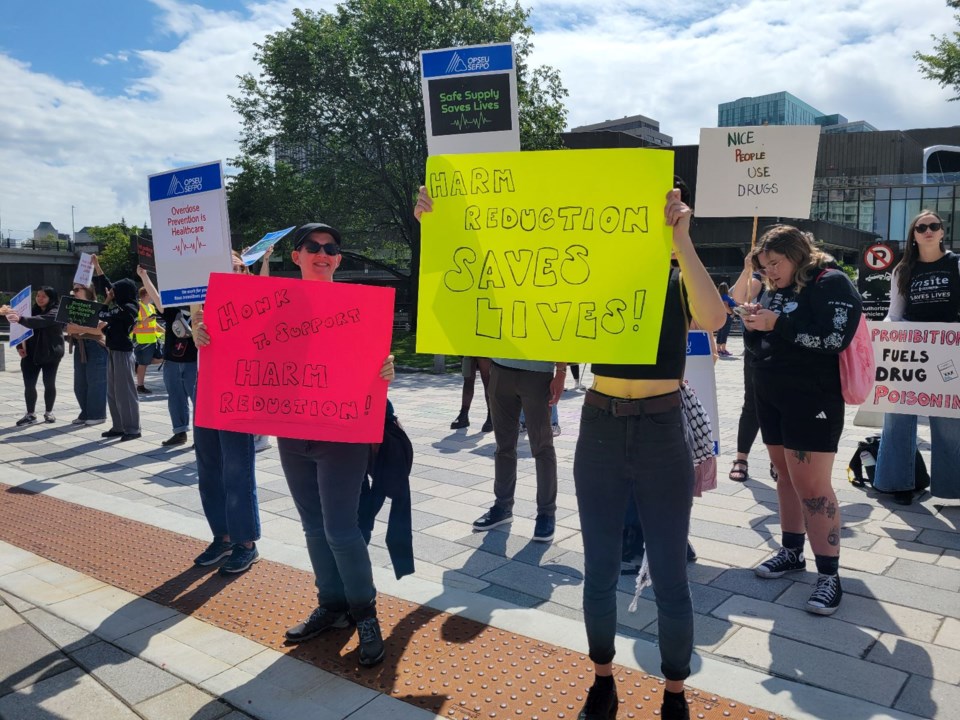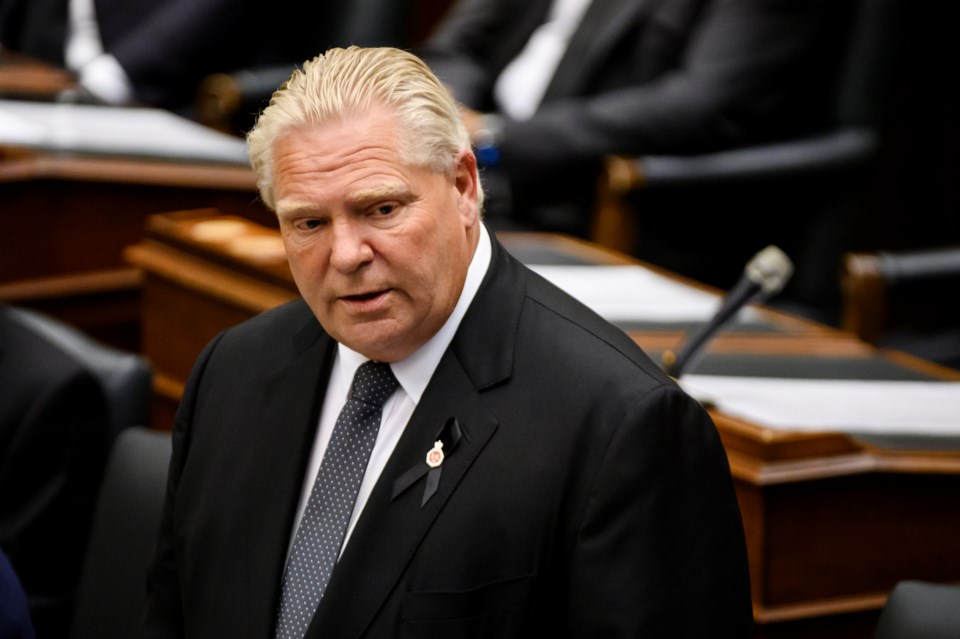EDITOR’S NOTE: This article originally appeared on The Trillium, a Village Media website devoted exclusively to covering provincial politics at Queen’s Park.
Ontario will shutter 10 consumption and treatment services sites and ban future ones, in a move some experts say will lead to more deaths and public drug use.
CTS sites, as they're known, allow people to use drugs inside without fear of arrest. Workers reverse overdoses and are required to connect users to mental health and treatment options. Most sites are run by community health centres or local public health units.
Sites within 200 metres of a school or child-care centre will have to close or transform into "Homelessness and Addiction Recovery Treatment (HART) hubs," Health Minister Sylvia Jones told a crowd of mayors, councillors and city and town staff at the Association of Municipalities of Ontario (AMO) conference in Ottawa on Tuesday.
The hubs will add up to 375 "highly supportive housing units," according to a government release, and aim to connect people to services including mental health treatment, primary care, employment help and other supports.
They won't offer safe supply programs, supervised consumption or needle exchange programs, the government said.
The government is putting $378 million toward creating 19 HART hubs. Applications from current CTS sites slated to close will be prioritized, Jones said.
In the fall, the government plans to also ban municipalities from participating in the federal safer supply program, and from requesting the feds to decriminalize drugs in their cities, as Toronto has done.
The following CTS sites will have to shut down by March 31, 2025. All except the Kensington Market location are funded by the province.
- Guelph Community Health Centre – 176 Wyndham Street North, Guelph
- Hamilton Urban Core Community Health Centre – 70 James Street South, Hamilton
- NorWest Community Health Centre – 525 Simpson Street, Thunder Bay
- Parkdale Queen West Community Health Centre (Bathurst) – 168 Bathurst Street, Toronto
- Regent Park Community Health Centre – 465 Dundas Street East, Toronto
- Region of Waterloo Public Health and Emergency Services – 150 Duke Street West, Kitchener
- Somerset West Community Health Centre – 55 Eccles Street, Ottawa
- South Riverdale Community Health Centre (Queen) – 955 Queen Street East, Toronto
- Toronto Public Health (The Works) – 277 Victoria Street, Toronto
- Kensington Market Overdose Prevention Site, The Neighbourhood Group – 260 Augusta Avenue, Toronto
Ontario will be left with nine consumption and treatment sites — including one each in Kingston, London, Peterborough and St. Catharines, two in Ottawa, and three in Toronto. There will be none in northern Ontario.
Jones cited concerns about crime in her speech.
"Parents are worried about the discarded needles that their children could pick up. Some parents no longer feel comfortable sending their children to the local elementary school or have pulled them out of their local daycare," she told a mostly silent AMO crowd.
The government promised the remaining CTS sites "will be held to greater accountability requirements," including a mandate to report all complaints to the province "to enable greater ministry oversight of any safety and security concerns."
Sites will also have to report regularly to the province on client numbers; create anti-loitering and "service restriction" policies; and work with police to do a security assessment every three years.
Applications for HART hubs will open in August and close in October, Jones said. The goal is to have the hubs open by the time CTSs are forced to close, she said.
It's unclear if there may eventually be more than 19 hubs. Jones said the government will start with that number before re-evaluating.
Sites closed as provincial review dragged on
Earlier this month, Premier Doug Ford said he was "not sold" on CTS sites, saying nearby neighbourhoods have needles "all thrown around" in them and are a "haven for drug dealers."
Ford started a review of supervised consumption sites last year after a shooting death near one in Toronto. As they waited for approval, sites in Barrie, Timmins and Sudbury that were approved by local leaders and the federal government were forced to close. Sault Ste. Marie's mayor had also hoped to open one.
"My office overlooks that site," Timmins Mayor Michelle Boileau said at an AMO panel on opioids on Tuesday. She said she's watched people "in large numbers" going in and out of the centre.
"And I can't help but wonder, every time someone goes up to the door and peers inside — and I see the look of confusion on their face, wondering why there's no one working inside — I can't help but wonder where they're going," she said.
An average of 10 people in Ontario are dying every day from tainted drugs, according to the Registered Nurses' Association of Ontario (RNAO).
“Nurses are enraged that we will see more preventable deaths. These numbers will increase because the Ford government has made it clear that people who use substances are disposable,” RNAO president and nurse practitioner Lhamo Dolkar said in a release.
Harm reduction vs. treatment a 'false antagonism'
Experts who research and work in addiction said the province needs both more harm reduction and more treatment.
The government is creating a “false antagonism” between the two choices, said Gillian Kolla, a population health professor at Memorial University.
"I think that rather than making public policy based on the best available evidence, instead we're doing it based on slogans, and that's very dangerous," she said.
Without supervised consumption sites, drug users may be "forced" to use them in public, making the issue more visible, Kolla said.
"What happens when those sites are closed and people are forced back into the alleys and the parks? How is that going to help anybody? How does that increase public safety or reduce public nuisance problems?" she said.
Northern Ontario, which will soon be without any CTS sites, has twice the overdose death rate of southern Ontario, Kolla noted.
Treatment unavailable to many: advocates
Kolla and Zoë Dodd, a harm reduction worker and researcher in Toronto, each said they'd welcome an increase in treatment, which is currently difficult to access and has gotten worse under the Ford government, according to Kolla.
"It tends to be one of those things that gets announced in a good news announcement, and then never actually turns into anything on the ground," Kolla said.
Dodd said she's helped multiple people access treatment.
To get into residential treatment, you must have detoxed, she said. Someone in Toronto might do so at CAMH, one of the small handful of detox sites in the province with medical staff on hand, she said. But after 10–12 days, that person will be released to wait for six to 12 months for a treatment bed.
In that time, without any other supports, most people go back to using drugs, she said.
And that's in Toronto.
The treatment journey for someone in Timmins — which still has a residential treatment facility and hospital — can be 1,500 kilometres, its mayor said. It's even more difficult in rural Ontario.
"It's a very broken system," Dodd said.
"It's not like, right on the spot, someone will talk to you and have something for you. That does not exist anywhere," she said.
"Every day, people are voluntarily trying to get support that they need — whether through the medical system, hospitals, CAMH, wherever — and they can't," Dodd said.
Treatment also varies in quality around the province, the experts said. One might be able to "skip the line" with a $30,000 treatment centre, but it might not have medical staff on hand, Dodd said. Otherwise, a free 12-step program might be their only option, she said.
"And then people are told that they're failures because they don't do well in these programs. But actually, the programs haven't changed. They're quite archaic and built off a model that was created in 1950s," Dodd said.
While treatment beds are important, clinical guidelines say the "first line" of treatment is opioid agonist therapy, which is medication, including suboxone and methadone — ideally, combined with counselling, said Lisa Simon, the associate medical officer of health at the Simcoe Muskoka Health Unit.
"In my opinion, everyone in Ontario who has an opioid use disorder should have access to that kind of treatment," she said, speaking at the AMO opioid panel.
'There's no debate' CTS sites save lives, connect people to services: doctor
Toronto's The Works site has intervened in over 2,300 overdoses since it opened; Ottawa's Somerset West has stopped 1,700, Kolla said.
CTS sites have been studied all over the world, added Simon.
"Bottom line, there's really no scientific debate. It works," she said, adding that it lowers rates of overdose, death and blood-borne infections.
"And importantly, we know it increases the likelihood of them connecting with other services when they want it."
Outside the conference, a handful of people converged to protest Jones' announcement before it happened.

Push back from opposition, municipal leaders
Jones thanked "the many municipal leaders who have engaged with us over the past several months, advocating for exactly this kind of community-oriented solution."
AMO itself is in favour of the sites. The organization, which advocates for all 444 municipalities in Ontario, noted in July that a study in the medical journal The Lancet credited the sites with a 42-per-cent reduction in overdose mortality in Toronto.
AMO President Colin Best welcomed the hub funding, but said in a release that CTS sites "are a critical part of tackling the opioid crisis.
"The evidence shows that harm reduction saves lives, saves money, and reduces crime. It takes the pressure off our police, paramedics, and hospitals," Best added.
Asked if AMO was consulted, Boileau, who is a board member, gave a polite, "No."
Ontario's NDP and Greens slammed the move while the provincial Liberal leader took a more tentative approach.
In a statement, NDP mental health and addictions critic Lisa Gretzky called it a "callous decision to take away a vital tool that saves lives.”
“Not a single community in our province is asking the government to take away existing resources and programs,” NDP Nickel Belt MPP France Gélinas said in the same statement. “This government is cynically attacking health infrastructure and putting ideology over evidence. It’s time to fund the treatments and support programs we need so we can stop the loss of life.”
Liberal Leader Bonnie Crombie said CTSs shouldn't be near schools, but decried a lack of "smart, compassionate solutions" from the premier, noting he dismantled the Opioid Emergency Task Force the previous Liberal government created when he took office.
"And now, Doug Ford is taking away more services," Crombie said in a statement. "He needs to be clear on how they will maintain the capacity required to provide treatment to those who need it."
Green Leader Mike Schreiner called for an immediate reversal, echoing advocates' sentiments that treatment vs. harm reduction isn't an "either-or scenario."
“Make no mistake – Ontario will lose more lives because of this government’s attack on harm reduction services," Schreiner said in a statement. "This decision is going to lead to more drug poisonings, more infectious disease spread and more people with one less pathway to judgement-free social services and addictions recovery treatment."
Health minister open to considering involuntary treatment
Some have urged the government to go further, like Cambridge's mayor, who has called for involuntary treatment for people with addictions. Two-thirds of respondents to a city-funded poll agreed that "Ontario’s laws needed to change to allow families and physicians to provide mental health and addiction treatment to involuntary patients."
Jones has poured cold water on the idea in the past, but took a different tone on Tuesday.
"I have concerns that involuntary treatment would not lead to the outcomes that we want," she said last month.
When asked about it after her speech, she said she is "willing to look at all the options."
